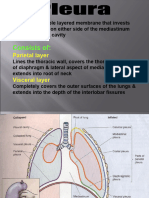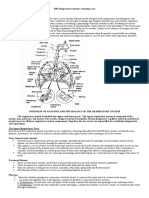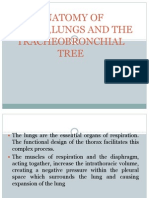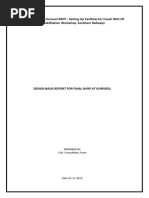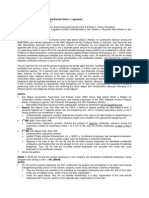0 ratings0% found this document useful (0 votes)
44 viewsLungs-WPS Office
Lungs-WPS Office
Uploaded by
zenith parmarThe lungs are located in the thoracic cavity, one on each side of the midline. Each lung has an apex, base, costal surface, and medial surface. The right lung has three lobes while the left lung has two lobes due to the heart's position. The lungs are surrounded by pleura and contained within the pleural cavity. Structures enter and exit the lungs at the hilum, including blood vessels, airways, and nerves. Gas exchange occurs across the thin respiratory membrane between alveoli and capillaries.
Copyright:
© All Rights Reserved
Available Formats
Download as PDF, TXT or read online from Scribd
Lungs-WPS Office
Lungs-WPS Office
Uploaded by
zenith parmar0 ratings0% found this document useful (0 votes)
44 views23 pagesThe lungs are located in the thoracic cavity, one on each side of the midline. Each lung has an apex, base, costal surface, and medial surface. The right lung has three lobes while the left lung has two lobes due to the heart's position. The lungs are surrounded by pleura and contained within the pleural cavity. Structures enter and exit the lungs at the hilum, including blood vessels, airways, and nerves. Gas exchange occurs across the thin respiratory membrane between alveoli and capillaries.
Copyright
© © All Rights Reserved
Available Formats
PDF, TXT or read online from Scribd
Share this document
Did you find this document useful?
Is this content inappropriate?
The lungs are located in the thoracic cavity, one on each side of the midline. Each lung has an apex, base, costal surface, and medial surface. The right lung has three lobes while the left lung has two lobes due to the heart's position. The lungs are surrounded by pleura and contained within the pleural cavity. Structures enter and exit the lungs at the hilum, including blood vessels, airways, and nerves. Gas exchange occurs across the thin respiratory membrane between alveoli and capillaries.
Copyright:
© All Rights Reserved
Available Formats
Download as PDF, TXT or read online from Scribd
Download as pdf or txt
0 ratings0% found this document useful (0 votes)
44 views23 pagesLungs-WPS Office
Lungs-WPS Office
Uploaded by
zenith parmarThe lungs are located in the thoracic cavity, one on each side of the midline. Each lung has an apex, base, costal surface, and medial surface. The right lung has three lobes while the left lung has two lobes due to the heart's position. The lungs are surrounded by pleura and contained within the pleural cavity. Structures enter and exit the lungs at the hilum, including blood vessels, airways, and nerves. Gas exchange occurs across the thin respiratory membrane between alveoli and capillaries.
Copyright:
© All Rights Reserved
Available Formats
Download as PDF, TXT or read online from Scribd
Download as pdf or txt
You are on page 1of 23
Lungs
Position and gross structure
There are two lungs, one lying on
each side of the midline in the thoracic
cavity. They are cone shaped and
have an apex, a base, a tip, costal
surface and medial surface.
The apex This is rounded and rises into the
root of the neck, about 25 mm above the
level of the middle third of the clavicle. It
lies close to the first rib and the blood vessels
and nerves in the root of the neck.
The base -This is concave and semilunar in
shape, and lies on the upper (thoracic) surface
of the diaphragm
The costal surface
This surface is convex and lies directly against the
costal cartilages, the ribs and the intercostal
muscles.
The medial surface
This surface is concave and has a roughly
triangular-shaped area, called the hilum, at the
level of the 5th, 6th and 7th thoracic vertebrae.
Structures forming the root of the lung enter
and leave at the hilum.
These include the primary bronchus, the
pulmonary artery supplying the lung and the
two pulmonary veins draining it, the bronchial
artery and veins, and the lymphatic and nerve
supply
The area between the lungs is the mediastinum. It is
occupied by the heart, great vessels, trachea, right and
left bronchi, oesophagus, lymph nodes, lymph vessels
and nerves.
The right lung is divided into three distinct lobes:
superior, middle and inferior.
The left lung is smaller because the heart occupies
space left of the midline.
It is divided into only two lobes:
superior and inferior. The divisions between the lobes
are called fissures.
Pleura and pleural cavity
The pleura consists of a closed sac of serous
membrane (one for each lung) which
contains a small amount of serous fluid.
The lung is invaginated (pushed into) into
this sac so that it forms two layers:
one adheres to the lung and the other to the
wall of the thoracic cavity
The visceral pleura
This is adherent to the lung, covering each
lobe and passing into the fissures that
separate them.
The parietal pleura
This is adherent to the inside of the chest wall
and the thoracic surface of the diaphragm. It
is not attached to other structures in the
mediastinum and is continuous with the
visceral pleura round the edges of the hilum
The pleural cavity
This is only a potential space and
contains no air. In health, the two layers
of pleura are separated by a thin film of
serous fluid (pleural fluid), which allows
them to glide over each other,
preventing friction between them during
breathing. The serous fluid is secreted by
the epithelial cells of the membrane
Interior of the lungs
The lungs are composed of the bronchi
and smaller air passages, alveoli,
connective tissue, blood vessels, lymph
vessels and nerves, all embedded in an
elastic connective tissue matrix. Each
lobe is made up of a large number of
lobules.
Pulmonary blood supply
The pulmonary trunk divides into the
right and left pulmonary arteries, which
transport deoxygenated blood to each
lung. Within the lungs each pulmonary
artery divides into many branches,
which eventually end in a dense capillary
network around the walls of the alveoli .
The walls of the alveoli and the
capillaries each consist of only one
layer of flattened epithelial cells.
The exchange of gases between air in
the alveoli and blood in the capillaries
takes place across these two very fine
membranes (together called the
respiratory membrane)
The pulmonary capillaries join up,
forming two pulmonary veins in each
lung. They leave the lungs at the hilum
and carry oxygenated
blood to the left atrium of the heart.
The innumerable blood capillaries and
blood vessels in the lungs
are supported by connective tissue.
You might also like
- Andrea Stolpe - Beginning Songwriting Writing Your Own Lyrics, Melodies and ChordsDocument168 pagesAndrea Stolpe - Beginning Songwriting Writing Your Own Lyrics, Melodies and ChordsVíctør Molina100% (1)
- Psychiatry BookDocument157 pagesPsychiatry BookSanaullah67% (3)
- Pleura: LungsDocument7 pagesPleura: LungsbarbacumlaudeNo ratings yet
- Anatomy of The LungsDocument8 pagesAnatomy of The LungschinecheremnfNo ratings yet
- Thorax 2Document250 pagesThorax 2Dureti DuretiNo ratings yet
- THORAX Part 2Document59 pagesTHORAX Part 2idrimuha333No ratings yet
- Nelson's Ana212 ProjectDocument4 pagesNelson's Ana212 Projectnomehnelson626No ratings yet
- The LungsDocument6 pagesThe LungsnandaNo ratings yet
- General Anatomy 4 Thoracic Cavity: Dr. Wesam BaderDocument46 pagesGeneral Anatomy 4 Thoracic Cavity: Dr. Wesam BaderAhmadNo ratings yet
- Anatomy Lec 13 (Lungs)Document28 pagesAnatomy Lec 13 (Lungs)afzal sulemaniNo ratings yet
- 20-Trachea, Bronchi & BPSDocument37 pages20-Trachea, Bronchi & BPSpm7197362No ratings yet
- Structure of The Pleurae: Parietal PleuraDocument7 pagesStructure of The Pleurae: Parietal PleuraGeorge WinchesterNo ratings yet
- Embryology, Gross Anatomy and Histology of Lungs and Pleura: For PC-II Medicine Students By: Zelalem ADocument58 pagesEmbryology, Gross Anatomy and Histology of Lungs and Pleura: For PC-II Medicine Students By: Zelalem AAmanuel MaruNo ratings yet
- Pleura & LungsDocument26 pagesPleura & Lungswashma SoomroNo ratings yet
- Parts of The LungsDocument2 pagesParts of The Lungsfcastellon358No ratings yet
- LungsDocument12 pagesLungsNyakie MotlalaneNo ratings yet
- Lungs and PleuraDocument7 pagesLungs and PleuraArvin ArliandoNo ratings yet
- Anatomy of The Lower Respiratory SystemDocument30 pagesAnatomy of The Lower Respiratory SystemBigg EbuskyNo ratings yet
- Lower Resp TractDocument32 pagesLower Resp TractTakshikaNo ratings yet
- ANA 215-210- Anatomy of the Lung MLS BNSC280120Document28 pagesANA 215-210- Anatomy of the Lung MLS BNSC280120garubakamilahNo ratings yet
- (Pulmones) : 1e. The LungsDocument4 pages(Pulmones) : 1e. The LungszhysanestebanNo ratings yet
- 19-Pleura & LungsDocument26 pages19-Pleura & Lungsjiransacaleb06No ratings yet
- LUNGSDocument14 pagesLUNGSNaman MishraNo ratings yet
- Trachea, Bronchial Tree and Bronchopulmonary Segments: by Nitisha GuptaDocument15 pagesTrachea, Bronchial Tree and Bronchopulmonary Segments: by Nitisha GuptaNITISHA GUPTANo ratings yet
- 20-Trachea,_Bronchi_&_BPSDocument55 pages20-Trachea,_Bronchi_&_BPSrachita3gabaNo ratings yet
- The Lungs - Position - Structure - TeachMeAnatomyDocument10 pagesThe Lungs - Position - Structure - TeachMeAnatomystephenokechukwu2007No ratings yet
- PresentationDocument17 pagesPresentationLyka Ann GonzagaNo ratings yet
- Anatomy 2Document43 pagesAnatomy 2bikedet268No ratings yet
- Thoracic cavity & contents: Thorax Unit Lecture 3 & 4 مسعلأا ليلج رديح .دDocument18 pagesThoracic cavity & contents: Thorax Unit Lecture 3 & 4 مسعلأا ليلج رديح .دMuhammad UsmanNo ratings yet
- 12.b. LUNGS - RSDocument46 pages12.b. LUNGS - RSmctime35No ratings yet
- Pleura Space Anatomy: Review ArticleDocument6 pagesPleura Space Anatomy: Review ArticleRohitNo ratings yet
- Unit 6 Part 2 Thoracic CavityDocument56 pagesUnit 6 Part 2 Thoracic CavitySiraj ShiferawNo ratings yet
- Anatomy and Physiology of The Respiratory SystemDocument5 pagesAnatomy and Physiology of The Respiratory SystemLek Bassig ReyesNo ratings yet
- Anatomy Personal NoteDocument7 pagesAnatomy Personal NoteShereen Al-ObinayNo ratings yet
- OxygenationDocument20 pagesOxygenationKhie-An OcampoNo ratings yet
- Repaso AnatomíaDocument2 pagesRepaso AnatomíasanchezyamnaylameyliNo ratings yet
- Anatomy of Pluera, Lungs and The Tracheobroncial TreeDocument108 pagesAnatomy of Pluera, Lungs and The Tracheobroncial TreeTahleel AltafNo ratings yet
- 12 Ana Lungs September 30 CinioDocument5 pages12 Ana Lungs September 30 CiniombdelenaNo ratings yet
- Anatomy RespiratoryDocument68 pagesAnatomy RespiratorydofezdsNo ratings yet
- LUNGS (1)Document30 pagesLUNGS (1)saroshbushra11No ratings yet
- Thoracic CavityDocument52 pagesThoracic CavityNorab Norab23No ratings yet
- Null 4Document47 pagesNull 4Kenyan MillanNo ratings yet
- MatthewVaracalloMD AnatomyThoraxBronchialDocument10 pagesMatthewVaracalloMD AnatomyThoraxBronchialLawson Mawulolo SetsofiaNo ratings yet
- LungsDocument10 pagesLungsEspiritu, ChriscelNo ratings yet
- Unit 5.2 Pleura and LungsDocument27 pagesUnit 5.2 Pleura and LungsBidhan RegmiNo ratings yet
- Trachea and LungsDocument25 pagesTrachea and LungsDr.pallavi kumariNo ratings yet
- Clinical Anatomy of Respiratory System: Dr. Ridwan Harrianto MHSC (Om), SP - OkDocument31 pagesClinical Anatomy of Respiratory System: Dr. Ridwan Harrianto MHSC (Om), SP - OkMahasiswa StrugleNo ratings yet
- Anatomy and Physiology Respiratory SystemDocument6 pagesAnatomy and Physiology Respiratory SystemCarlos Alfonso Borromeo AmoresNo ratings yet
- Lecture 5 Serous Sacs, Features and FunctionsDocument7 pagesLecture 5 Serous Sacs, Features and Functionssomebody_maNo ratings yet
- ScriptDocument3 pagesScriptAubrey GadorNo ratings yet
- LungsDocument2 pagesLungsAlex MiuNo ratings yet
- Seminar On: Pulmonary TuberculosisDocument33 pagesSeminar On: Pulmonary TuberculosisPriyaranjan Jose88% (8)
- The Heart - NotesDocument11 pagesThe Heart - NotesLast AccNo ratings yet
- 4_Pleura_and_lung (1)Document29 pages4_Pleura_and_lung (1)jafartayeb9No ratings yet
- Anatomy 2Document43 pagesAnatomy 2Aslı NilNo ratings yet
- Var 29 - 30Document4 pagesVar 29 - 30Honey BabaNo ratings yet
- BBS2-AO-K2 Mediastinum, Thymus, Tiroid & PulmoDocument47 pagesBBS2-AO-K2 Mediastinum, Thymus, Tiroid & PulmoYoanNo ratings yet
- Pc Simplified Anatomy Series-thorax01Document16 pagesPc Simplified Anatomy Series-thorax01Ashley oguNo ratings yet
- RespsystempptDocument32 pagesRespsystempptAhmed YousefNo ratings yet
- The Respiratory System BME 405ADocument8 pagesThe Respiratory System BME 405AMariam ZakariaNo ratings yet
- Circulatory System: A Tutorial Study GuideFrom EverandCirculatory System: A Tutorial Study GuideRating: 5 out of 5 stars5/5 (3)
- Pioneer Avh-P5000dvd SM 1 (ET)Document201 pagesPioneer Avh-P5000dvd SM 1 (ET)Jesus LopezNo ratings yet
- Design Calculations of Chiller FoundationDocument15 pagesDesign Calculations of Chiller FoundationStressDyn Consultants100% (1)
- The Second English Exam: Task OneDocument1 pageThe Second English Exam: Task OnekaderNo ratings yet
- MdugDocument1,347 pagesMdugYoungmi KwonNo ratings yet
- Internal Audit Ethics in An OrganizationDocument14 pagesInternal Audit Ethics in An Organizationsrini vasNo ratings yet
- Tripura-Rahasya (Jnankhanda)Document13 pagesTripura-Rahasya (Jnankhanda)mallikai_1No ratings yet
- Prometric India Contact NumberDocument4 pagesPrometric India Contact NumberWANNA WOHNo ratings yet
- Tuesday, June 3, 2014 Hearing Room #1, North Office Building (Main Capitol Complex)Document2 pagesTuesday, June 3, 2014 Hearing Room #1, North Office Building (Main Capitol Complex)Christopher A. KrafcikNo ratings yet
- Stuktur SVM Tek Kimpalan 2017Document1 pageStuktur SVM Tek Kimpalan 2017Cikgu Azry Azeem PetronessaNo ratings yet
- WIP 1800 2000kcal Computation Table 601525Document6 pagesWIP 1800 2000kcal Computation Table 601525jannel.dioquinoNo ratings yet
- Classical TuningDocument8 pagesClassical TuningElena Mariana CristeaNo ratings yet
- The Barrel Room MenuDocument8 pagesThe Barrel Room Menutristan.cameronNo ratings yet
- Why Does He Bring Home More Bacon Than I Do - Student's VersionDocument6 pagesWhy Does He Bring Home More Bacon Than I Do - Student's VersionRegina ReginaNo ratings yet
- Public Sensitisation On The Adoption of Renewable Energy in Nigeria: Communicating The Way ForwardDocument9 pagesPublic Sensitisation On The Adoption of Renewable Energy in Nigeria: Communicating The Way ForwardLandon Earl DeclaroNo ratings yet
- Education From Waste: Presented By: Solomon GitauDocument13 pagesEducation From Waste: Presented By: Solomon GitauEasye TroublejNo ratings yet
- Licenta Astm Bronsic Irimescu CarmenDocument104 pagesLicenta Astm Bronsic Irimescu CarmenCornel CornelNo ratings yet
- 2021-2022physical SecurityDocument30 pages2021-2022physical SecurityJoseMelarte GoocoJr.No ratings yet
- CASE 2 Mambulao Lumber Vs Philippine National BankDocument3 pagesCASE 2 Mambulao Lumber Vs Philippine National BankmmhNo ratings yet
- Quiz #2Document1 pageQuiz #2Aldrin taduranNo ratings yet
- Gynecology SoftwareDocument43 pagesGynecology SoftwareVikas MahurkarNo ratings yet
- San Miguel Corp. Supervisors and Exempt Union v. LaguesmaDocument2 pagesSan Miguel Corp. Supervisors and Exempt Union v. LaguesmaJoanne Macabagdal100% (3)
- McPhaul v. United States, 364 U.S. 372 (1960)Document12 pagesMcPhaul v. United States, 364 U.S. 372 (1960)Scribd Government DocsNo ratings yet
- Informatica Power CenterDocument2 pagesInformatica Power Centertirupatirao pasupulatiNo ratings yet
- Futuristic BackgroundDocument21 pagesFuturistic Background202340232No ratings yet
- Ilovepdf MergedDocument13 pagesIlovepdf Mergedcoding727treeNo ratings yet
- Cam 18 Reading Test 4Document5 pagesCam 18 Reading Test 4Phan Thành HưngNo ratings yet
- I-4AM 2024 PosterDocument1 pageI-4AM 2024 Postertikehoh610No ratings yet
- Chapter 4 Major Organic ReactionDocument55 pagesChapter 4 Major Organic ReactionTolera TadesseNo ratings yet











